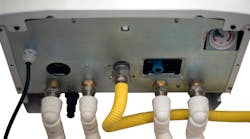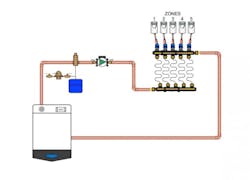Several years ago, I got a call from an HVAC contractor in southern Minnesota who was troubleshooting a radiant system for a residential customer. Since he wasn’t really confident working with radiant, he called to see if I might shed some light on this job.
Apparently, the customer was experiencing extremely high heating bills, and some of the rooms in the home were cold. He related that the boiler, pump and controls seemed to be working properly, so he wasn’t sure of the next step in the troubleshooting process.
As he continued to explain the whole story, it became quite a sad one. The customer, it turns out, was an 80-year-old widow who had sold the family farm when her husband passed away and built her dream home on part of the old homestead. The new home was a 2,250-sq.ft., slab-on-grade structure with the entire living area on one floor. Everything was nice and convenient. She had put extra money into the home for good insulation and high-quality windows to prepare for those long, cold Minnesota winters, so the house was exceptionally airtight and energy-efficient.
She had chosen to have radiant heat in the home, and the initial contractor had talked her into installing five heating zones, so she could set each room to whatever temperature she wanted. She went on to say that her propane bills were running as high as $800 per month in the spring and fall, and some of the rooms were cold, no matter what temperature she set the thermostat. She said the odd part was that during the middle of winter — in the really cold months — the heating bill actually plummeted to $200 and the home actually felt warmer.
She tried to contact the original installer, but he was nowhere to be found. He had left no heat-loss analysis, no drawings of the tubing, no instructions … nothing. Minnesota is one of the many states that does not require certification or licensure to be a hydronic heating installer, so there was no way to know if he was even competent to install the system in the first place. She had then called two other heating contractors to try to fix the problems. Each came to the home, turned up the boiler temperature and told her it would get better. It didn’t. She said she would have to sell the home if she couldn’t get the fuel bills to come down.
Unfortunately, this story actually has two issues — the first being how to fix the customer’s radiant system properly. The second issue, which I will discuss at the end of this article, relates to the lack of a national certification process for hydronic heating designers and installers and the importance of enacting change in our industry to greatly reduce the occurrence of inadequate designs and improper installs.
Propane diet
So, for the first issue at hand, I needed to help this customer get the problem solved. We needed to put the boiler on a propane diet. I had already formed an opinion in my mind as to what I thought was the problem, but I asked the HVAC technician to verify it by sending me a couple details of the job. I asked for the information from the boiler data plate, the primary pump details and a drawing of how the system was piped. I also asked for the model number of the windows and doors, what kind of insulation was used when the home was built, and a rough floor plan detailing room sizes and where the thermostats were mounted.
Since there was no heat-loss analysis available, we were going to have to reverse-engineer a heat-loss analysis with the information we had on hand. The boiler was a modulating-condensing boiler with a 5-to-1 turndown ratio and 100,000-BTU input. The pump was a three-speed, wet-rotor circulating pump with a mid-curve output of 10 gallons per minute (GPM). Below is a rough drawing of the piping system installation.
Let’s put all of this information together to see if we can sort out the problem. First, we needed to start by re-creating a heat-loss analysis as best as we could. The home had R-19 walls, R-43 ceilings, R-3.5 glass and R-7 doors. With the floorplan we were given, we did a heat-loss analysis using a free computer heat-loss analysis program called Advanced Design Suite. We determined the heat loss was about 14.7 BTUs/hr/ft2 (we’ll say 15 for this exercise). This is a pretty typical heat loss for a newly built, well-insulated home in a northern region.
This means that during the coldest weather in the middle of winter, this particular house is going to require 15 BTUs/hr/ft2 to keep the house warm. If we multiply the 15 BTUs/hr/ft2 x 2,250 (the square footage of the home), we get 33,750 BTU/hr. This means that when it is -15°F in the middle of winter, this home is going to need 33,750 BTUs to heat the home. As the outside temperature warms up, we will need less and less of these 33,750 BTUs so that on a 40°F day, we would only need about 5,500 BTUs to heat the home.
Over-sizing = short cycling
Now we can start to see the problem. This is a classic case of oversizing. The heat-loss analysis tells us we need 33,750 BTUs in the dead of winter to heat the home, and we have a 100,000-BTU boiler. We literally have enough boiler capacity to heat three of these homes!
Oversized boilers produce a condition called short-cycling. This is where the boiler fires up on a call for heat and tries to dump 100,000 BTUs into a system that needs 33,750. You can check this out in your own home. Go down to the mechanical room on a really cold day and watch your boiler (or furnace) fire. If it fires for three minutes, shuts off and waits five minutes and fires again for three minutes, it is very likely to be oversized.
Boilers run most efficiently for longer times with a smaller flame. Fortunately, this is a modulating boiler with a 5:1 (5-to-1) turndown ratio. That means that the boiler is capable of measuring the outside temperature and throttling down the fire in the boiler all the way to 20,000 BTUs (100,000 ÷ 5 = 20,000). The 5 comes from the turndown ratio of 5:1.
The problem comes in the spring and the fall when the home needs only 5,500 BTUs. The boiler low-fires at 20,000 BTUs, but the house only needs 5,500 BTUs, so the temperature inside the boiler heats up really fast. So fast, in fact, that it shuts itself off by the high-limit control inside the boiler to protect itself from overheating. But the call for heat is still there from the thermostat, so the boiler allows itself to cool down and then tries to re-fire again.
Over and over the boiler fires, rapidly heats up, shuts itself off on high-limit, cools down and fires again. And all the time it is doing this, the thermostat is still not satisfied, so it keeps getting cooler and cooler in the room. This is short-cycling. And that is what was causing the homeowner’s $800 fuel bills in the spring and fall. (Short-cycling will also significantly shorten the life of the boiler as well.)
As bad as this problem is, it gets much worse. Suppose only one of the five zones is calling for heat and that zone has a need for only 1,000 BTUs/hr for that day. Now we have a 20,000-BTU boiler firing for 1,000 BTUs. The short cycling becomes even more severe and even more damaging, and the room calling for heat would still be cold. The more zones you have on a system, the smaller the loads of those zones, and the worse the short cycling. (So much for comfort and efficiency.)
So, how do we fix this?
We have at least two options to remedy the situation.
The first would be to tear out the existing boiler and replace it with a 40,000 to 50,000 BTU modulating-condensing boiler. Since this isn’t the contractor who originally installed the boiler, from a business standpoint, he would need to charge her for a new boiler plus installation. That could cost $3,000 to $4,000. Yikes!
A good second option would be to install a buffer tank and one additional pump. A correctly sized buffer tank would allow the boiler to fire for a considerably longer time, thus stopping the short cycling. It would store that heat in the buffer tank until the load required it.
In essence, as far as the load is concerned, the buffer tank is now the new heat source, not the boiler. The boiler’s only job is to fill the buffer tank with heat. If the mechanical room has enough room, installing a buffer tank is easier and more cost-effective.
The only questions left are: How big of a buffer tank and how big of a secondary pump do we need? Here is the formula:
Where:
BT = Required volume of the buffer tank (gallons)
t = Desired duration of the heat source’s “on” cycle (minutes) — usually 5-10 minutes for geothermal; 10-20 minutes for gas
Qh = Heat output rate of the heat source (Btu/hr). In this case, a 100,000 Btu boiler that is 95% efficient would have an output of 95,000.
Ql = Rate of heat extraction from the tank (Btu/hr) (load). In this case, the smallest load is 1,000 BTUs.
ΔT = Temperature rise of the tank from when the heat source is turned on to when it is turned off (°F); typically 20-40 degrees.
Let’s see what size buffer tank we need.
In this case, we would need a minimum of 47 gallons to stop the short cycling. (Try playing with some longer run times and wider Delta Ts.)
We called in a couple favors from some local vendors and got a 50-gallon buffer tank and shipped it down to the contractor, along with a variable Δp pump. They were up and running in no time. Below is a drawing of the new piping.
Now the homeowner has the correct amount of heat when she needs it. Her propane bills dropped from $800 per month in the spring and fall to a little more than $100 per month, and she had no more cold rooms. It was a tankless job, but someone had to do it.
Now, for the second issue I mentioned earlier in the article. More and more people in the industry are coming forward to say that we need a certification for hydronic heating designers and installers. There are just way too many of these stories floating around of incompetent installers and exploited consumers. Some states have certifications or licenses, but many do not.
I have been advocating for years to bring a national certification system for hydronic installers to the industry, and it is now my extreme pleasure to be the chairman of the hydronic certification committee for IAPMO. The committee is made up of installers, designers and manufacturers who have decades of technical knowledge and hands-on experience. They are the very best in the business.
Working with Mark Eatherton and the whole IAPMO organization has been a rewarding and educational learning process that has benefitted me, and I know it will benefit our industry. We look forward to serving the hydronic community to provide competent and certified installers and designers for the industry.
I will keep you posted. I would be grateful to hear your thoughts, ideas and stories. You can reach me at [email protected].
Until then, best regards and happy heating.
Steve Swanson is the customer trainer at Uponor Academy. He can be reached at [email protected].








